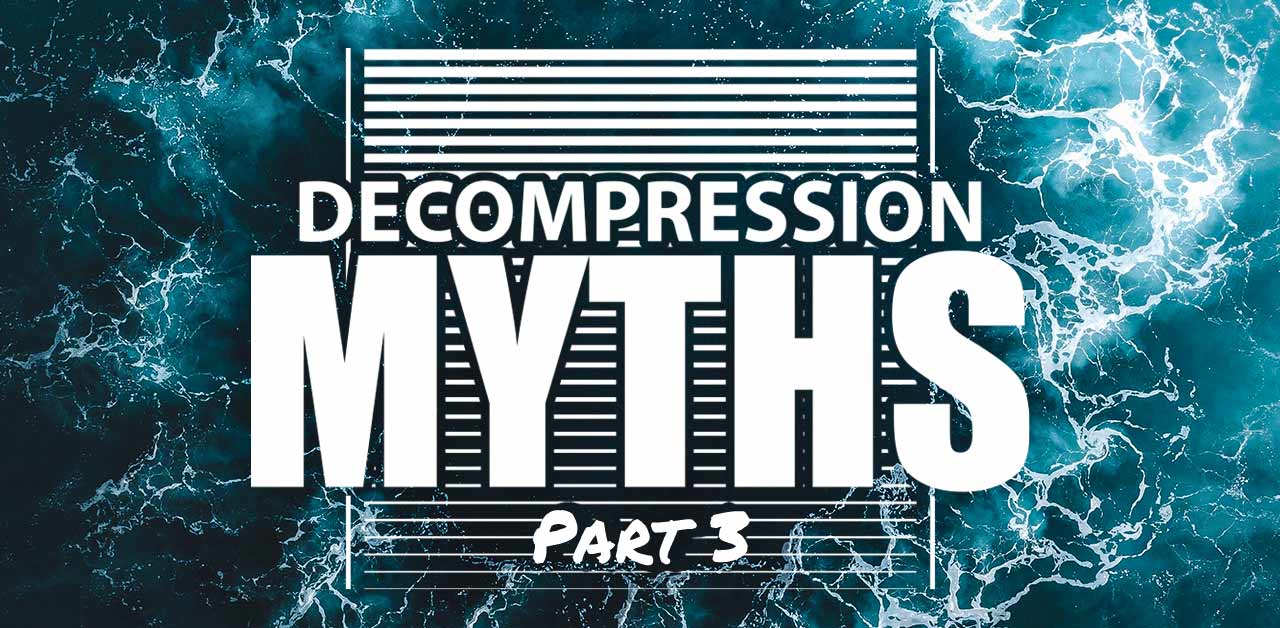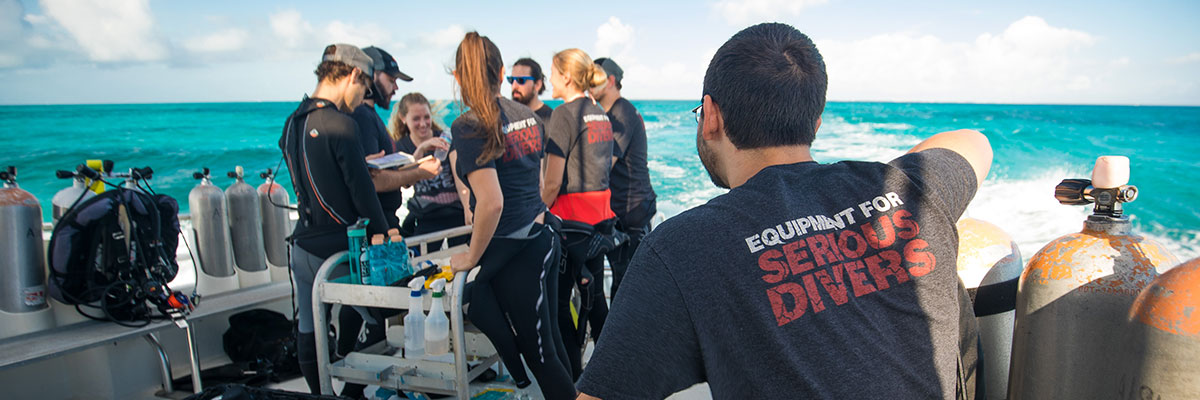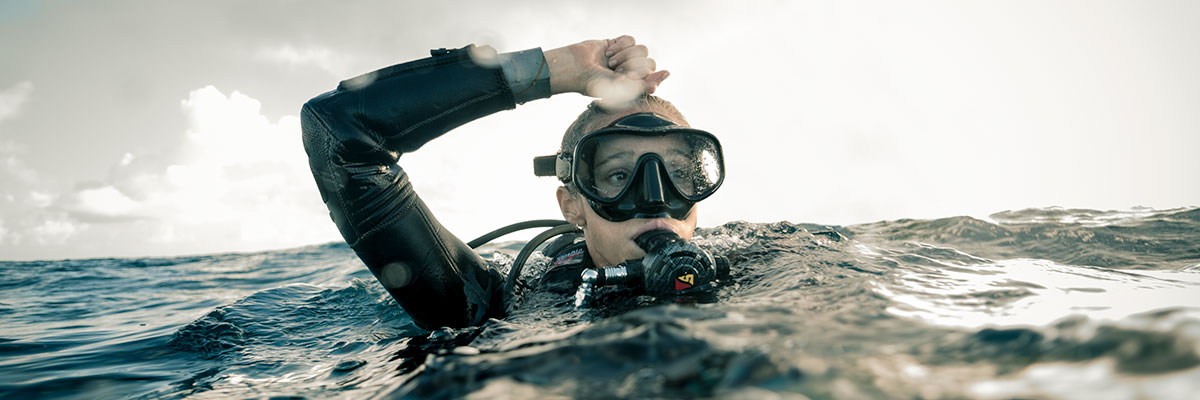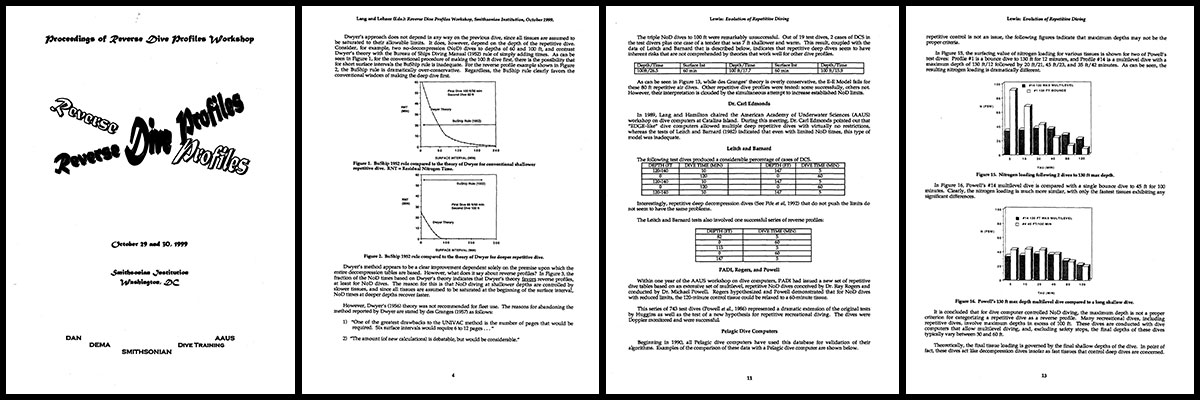Blogs
Decompression Myths: Part 3

By Mark Powell
In the [first] and [second] articles in this series I covered some myths that may have made you think about things in a slightly different way but on the whole were fairly uncontentious. This article may be a bit more contentious as the subject we are going to discuss is a topic that is regularly taught by some agencies and instructors yet has been shown to be a myth.
When I learnt to dive, I was taught there were three golden rules;
1. Never hold your breath while ascending
2. Never dive alone
3. Never dive deeper than your previous dive.
This was in the late 80s and things have moved on since then then in many ways. Equipment has changed beyond recognition and so have many training practices. SDI was launched in 1998 and just one of many firsts was the launch of a Solo Diver program which has shown the diving industry that it is possible to solo dive if you are properly trained, equipped and have the right mindset. For more detail on how the approach to solo diving has changed take a look at this [https://vimeo.com/49259855].
Equally, the idea that you should never dive deeper than your previous dive (also known as a reverse profile) has also been revisited. If you were taught that you should never dive deeper than your previous dive for safety reason in the last 5, 10 or even 20 years then that information is based on an outdated view. The reason I say up to 20 years is that the ‘revisited’ information is based on the Reverse Profile workshop that was held in 1999. In other words, this information has been available for over 20 years.
The information below is not just my view or the view of an individual training agency. The reverse diving workshop was held at the Smithsonian Institute and was organised by DAN, AAUS, DEMA and Dive Training magazine. In other words, it was a genuine scientific workshop and so its findings should be taken seriously.
These workshops are held regularly and the intention is to review key principles and to see if the scientific recommendations are still valid, or whether they need to be updated based on more recent evidence. They follow the same overall format. First the original evidence that led to the current guidance is reviewed, then any more recent evidence is reviewed and finally a recommendation is made based on the total evidence. In this case they followed the same procedure but when they came to review the evidence upon which the original recommendation was based, they made an interesting discovery. There was no scientific evidence that was originally used to create this golden rule. In tracing the background to this rule, they found the first mention of it was in an agency training manual from 1974. This manual stated that if you do the deeper dive first, and a shallower dive second, then you will get more overall dive time according to the tables. This is absolutely true, almost all tables will give the same result. However, there was no indication at this point that it was for any safety reason. Subsequent iterations of this and other training manuals gradually strengthened this statement until, eventually, it became the absolute rule that “though shall never diver deeper than your previous dive”. However, as the workshop discovered, this was never based on any scientific evidence that this was because reverse profiles were more risky than ‘normal’ profiles.
MYTH: Never dive deeper than your previous dive
Furthermore, the workshop confirmed that since the introduction of this rule there had been no subsequent research that showed an increased risk of DCS with reverse profile diving. This should not really be a surprise as many commercial, scientific and even large numbers of rogue recreational divers have been doing reverse profile dives with no apparent increased risk for many years.
In order to remove any doubt, the findings and conclusions of the workshop are reproduced below in full.
Findings:
- Historically, neither the U.S. Navy nor the commercial sector has prohibited reverse dive profiles.
- Reverse dive profiles are being performed in recreational, scientific, commercial and military diving.
- The prohibition of reverse dive profiles by recreational training organizations cannot be traced to any definite diving experience that indicates an increased risk of DCS.
- No convincing evidence that reverse dive profiles within the no decompression limits lead to a measurable increase in the risk of DCS was presented.
Conclusion:
– We find no reason for the diving communities to prohibit reverse dive profiles for no-decompression dive profiles less than 40 m/130fsw and depth differentials less than 12 m/40fsw.
If you want even more information and want to read the full details of the workshop the final report is available in full [https://repository.si.edu/handle/10088/2724].
From this we can see that there is no evidence for banning reverse profiles based on safety reasons. Of course, there may be other reasons why doing the deeper dive first may be a good idea. We have already discussed that you will get more overall No Stop Time on the tables if you do the deeper dive first. In addition, if you do a deeper dive first and use up some of you gas you can potentially do a shallower second dive while staying within safe gas limits whereas this may not be possible the other way around. Finally for divers that suffer from ear problems sometimes a deeper second dive may cause difficulties with equalisation.
However, the key point is that none of these relate to DCS risk. This is an important point because, if you remember from the first article, I said that one of my intentions is to promote a better understanding of DCS risk. If we are telling divers that there is an increased risk of DCS with reverse profile diving, when the scientific evidence says otherwise, we are reducing understanding of DCS risk rather than increasing them. You might not think this is important but I think if we have a key principle of decompression theory that instructors teach as a fundamental safety rule but science says is not true then divers may also question what other key rules are not true.
Sticking to a rule just because that is what we were first taught when the scientific evidence indicates it is not true just serves to spread misunderstanding and is exactly why myths develop. So next time you hear someone saying it’s safer to do your deepest dive first ask them what evidence they have for that.
Just in case you were wondering; the rule that you should never hold your breath while ascending is still good advice.
Blogs
Jeff Goodman Launches Underwater Moviemaker Course with NovoScuba

Transform Your Dive Experiences into Cinematic Masterpieces
NovoScuba has partnered with acclaimed underwater filmmaker Jeff Goodman to introduce the Underwater Moviemaker Course—a revolutionary program designed to equip divers with the skills to capture the breathtaking beauty of the underwater world.
Whether you’re an aspiring filmmaker, an avid diver, or a photography enthusiast, this course offers the tools and expertise needed to create stunning underwater videos. From vibrant coral reefs to curious marine life, you’ll learn how to film, edit, and produce captivating underwater stories, all with expert guidance from a seasoned professional.
Jeff Goodman: A Legacy in Underwater Filmmaking
Jeff Goodman brings over 40 years of experience in underwater film production for television to this course. Reflecting on his career, Jeff said:
“Although technology has dramatically changed, the basics of underwater filming remain constant. This course covers crucial skills for producing great videos. Whether you’re creating professional broadcast films or high-quality hobby videos, the fundamental principles are the same.
A camera operator must master their equipment to capture those magical underwater moments effortlessly. But beyond technical know-how, underwater filmmaking is about having fun and enhancing your diving experiences. So, take your time, learn at your own pace, and enjoy this creative journey.”
About NovoScuba
Founded in 2023, NovoScuba is reshaping dive education with a comprehensive, digitally native platform. Offering cutting-edge training programs for divers at all levels, NovoScuba sets a new benchmark in the diving industry by combining innovation with accessibility.
With ISO-certified courses, a student subscription model, and multilingual support, NovoScuba ensures that dive education is inclusive and engaging. More than just a training provider, NovoScuba fosters a global community of divers committed to exploration, collaboration, and sustainability.
Join the NovoScuba Underwater Moviemaker Course Today!
Dive into the world of underwater filmmaking and start creating cinematic stories that inspire. Learn more about the course and enroll today at www.novoscuba.com/novoscuba-underwater-moviemaker-course.
EXCLUSIVE: Jeff Goodman interviews Mark Spiers, CEO of New Scuba Diving Training Agency NovoScuba
NovoScuba’s Game-Changing Approach for Dive Store Owners: WE PAY YOU!
The diving world thrives on passion and adventure, but for many dive store owners, the financial and operational challenges can be as deep as the ocean.
NovoScuba, an emerging force in the diving world, is on a mission to transform this landscape for the better. With a revolutionary approach to dive store and training agency partnerships, NovoScuba is setting new standards for how dive stores can thrive while keeping their focus on delivering exceptional diving experiences.

A New Paradigm: NovoScuba’s Bold Mission
NovoScuba’s mission is straightforward yet profound: to disrupt the traditional dynamics between dive store owners and training agencies. Traditionally, dive stores have been subjected to substantial fees charged by training agencies, for membership, materials and certifications. These costs have often placed a heavy financial burden on store owners, cutting into their profits and limiting their ability to offer competitive prices to customers.
NovoScuba flips the script by offering a model where dive stores earn money, instead of paying high fees. Dive stores receive commissions for every student they register, and their certification costs are covered. This new model not only boosts profitability but also ensures clients get top-quality training at unbeatable prices.
Financial Upsides: Earn From Student Registration
NovoScuba’s approach is simple yet revolutionary. Dive stores partnering with NovoScuba can earn commissions for every student they enroll.
Here’s how it works: For every student enrolled through NovoScuba, dive stores receive a commission. Each student enrolled will receive their e-learning materials and certification credit included in their subscription. This arrangement is a significant departure from the traditional model, where dive stores often struggle to manage high overhead costs related to training fees and certification expenses.

NovoScuba’s approach ensures that dive stores can focus on what they do best—providing top-notch diving experiences—without being bogged down by excessive financial burdens, and the need to carry large stocks of materials.
Quality Training at a Great Price
NovoScuba stands out by offering high-quality, ISO certified, training that doesn’t break the bank, in fact our students will pay less than with most competing agencies. Clients benefit from top-notch education and safety standards at competitive prices. Dive store owners can confidently promote NovoScuba’s programs, knowing they’re offering fantastic training at affordable rates. This balance of quality and affordability helps dive stores build a strong reputation and attract more customers.
Your Brand is Your Business: NovoScuba’s Commitment to Showcasing Your Identity
At NovoScuba, we understand that your brand is your most valuable asset, and we’re committed to putting it front and centre. Unlike agencies that charge high fees to promote their own brand, we believe in investing in yours. With NovoScuba, you won’t be paying to advertise someone else’s logo alone, — our focus is on showcasing your unique identity. Certifications prominently feature your brand, as well as the training agency, reinforcing your store’s image and brand every step of the way. We’re here to support and elevate your brand, ensuring that your investment directly benefits your business.
Affordable Membership: An Investment in Your Success
NovoScuba’s membership model is designed with dive store owners in mind. Membership fees are kept low and include annual Pro member fees for your team. Payment can be made monthly or annually in your local currency, avoiding the hassle of exchange rate fluctuations. NovoScuba promises no exchange rate changes without a six-month notice, ensuring financial stability and simplifying budgeting. With a membership lasting 12 months from date of joining, you’ll enjoy a full year of NovoScuba’s benefits and support.

Streamlined Operations: Simplifying Your Workload
Handling administrative tasks can be a challenge, but NovoScuba makes it easier. We’ve streamlined certification procedures and reduced paperwork to help dive stores operate more efficiently. Certification processing is quick and straightforward, allowing more focus on teaching and customer service. Our system minimises bureaucracy by storing necessary forms in student profiles, reducing paperwork and administrative delays.
Crossover Made Easy
For dive stores looking to transition to NovoScuba’s model, the crossover process is designed to be smooth and hassle-free. NovoScuba provides support to ensure that the transition is as seamless as possible, helping dive store owners integrate into the new system with minimal disruption. Experienced dive Pros don’t need to undergo extensive retraining. Our crossover is designed to familiarise Pros with NovoScuba’s user-friendly platform, standards and course structures, and not to waste time and expense re-training in water.
With just a few simple steps, you’ll be ready to offer top-notch training through NovoScuba.
Comprehensive Business Support and Training Included in Your Membership
NovoScuba goes beyond financial benefits by offering experienced support and training. This value added service includes:
- Business Training: Optimise your operations with guidance on marketing, customer service, and best practices.
- Marketing and Promotion: Access resources to attract new customers and boost your store’s visibility. Enjoy cross promotions with NovoScuba to gain increased exposure.
- Ongoing Support: NovoScuba’s commitment to its partners extends beyond initial training and setup. The company offers ongoing support to address any issues or questions that arise. This continuous support ensures that dive store owners have a reliable resource to turn to whenever they need assistance.

Embracing Digital Natives: Instant Evolution and Continuous Improvement
NovoScuba’s digital-native approach is a game-changer. Leveraging cutting-edge technology, we ensure our services evolve and improve swiftly. Dive stores benefit from instant updates, the latest features, enhancements, and effective solutions, keeping them ahead of the curve. This continuous improvement helps dive stores stay competitive and deliver exceptional services. Whether it’s a new course update, additional marketing resources, or improved e-learning functions, NovoScuba’s digital infrastructure ensures that dive stores are always equipped with the most current and effective solutions. This continuous evolution not only helps dive stores stay ahead in a competitive market but also ensures they consistently provide top-quality services to their clients.
Why Is NovoScuba Doing This? – Fair Profit Sharing for Greater Access and Growth
At NovoScuba, we’ve taken a bold step by paying commissions to stores rather than following the traditional model of training agencies charging high fees. Our mission is to make diving accessible to everyone and to foster a growing community of new divers and continued education. By redistributing profits more equitably between stores and training agencies, we aim to create a more supportive and collaborative environment within the industry. We believe this approach not only helps individual stores thrive but also stimulates overall growth and innovation in diving. Our commitment to fair profit sharing reflects our dedication to the long-term health and expansion of the diving community.

Everyone is getting a piece of the pie.
Getting Started: Join the NovoScuba Revolution
Ready to revolutionise your dive store experience? NovoScuba is here to support your journey toward reduced costs, increased profitability, and enhanced operational efficiency. Get in touch with our team to learn how NovoScuba can transform your business.
For more information, email info@novoscuba.com or visit www.novoscuba.academy.
Blogs
Experience World-Class Diving and Luxury at its Finest with Lumbalumba Resort

Lumbalumba Resort – Manado is an intimate dive and snorkel retreat nestled in Manado, North Sulawesi, Indonesia—a hidden gem within the world-renowned Coral Triangle, home to the planet’s highest marine biodiversity.

Email: info@lumbalumbaresort.com / Call: +62 (0) 812 430 2974 / Web: www.lumbalumbaresort.com
With only six luxurious chalets (just nine rooms), we provide a cozy, flexible atmosphere where every guest receives the genuine, personal attention they are looking for.

Email: info@lumbalumbaresort.com / Call: +62 (0) 812 430 2974 / Web: www.lumbalumbaresort.com
Our philosophy is simple: we can only succeed when you’re truly satisfied. Choosing to stay small allows us to deliver the extra-special, personalized service you seek, making your experience here genuinely unforgettable.
For us, you’re not just another tourist.
For you, we’re not just another dive resort.

Email: info@lumbalumbaresort.com / Call: +62 (0) 812 430 2974 / Web: www.lumbalumbaresort.com
Rustique situated in our lush bontanical gardens are 3 different types of accommodation, including a family Chalet.

Email: info@lumbalumbaresort.com / Call: +62 (0) 812 430 2974 / Web: www.lumbalumbaresort.com
Enjoy a relaxing dip in our infinity pool, unwind at the bar, and savor mouthwatering dishes from our renowned kitchen—each meal crafted to delight your taste buds in every bite.

Email: info@lumbalumbaresort.com / Call: +62 (0) 812 430 2974 / Web: www.lumbalumbaresort.com
Lumbalumba Resort has two different kinds of boat; our inboard powered, custom-made catamaran, Diver III, and Diver IV, our fast outboard-powered dive boat.

Email: info@lumbalumbaresort.com / Call: +62 (0) 812 430 2974 / Web: www.lumbalumbaresort.com
Both are very comfortable with lots of space to relax from, to and in between dives.

Email: info@lumbalumbaresort.com / Call: +62 (0) 812 430 2974 / Web: www.lumbalumbaresort.com
Experience stunning visibility and vibrant coral reefs teeming with schooling fish. Bunaken is also a haven for marine life, boasting a thriving population of Hawksbill and Green Sea Turtles. It’s not uncommon to encounter 15 to 20 turtles on a single dive or snorkeling trip!

Email: info@lumbalumbaresort.com / Call: +62 (0) 812 430 2974 / Web: www.lumbalumbaresort.com
But it’s not just about the big sights and wide-angle views. Close to the resort, you’ll find numerous muck and macro dive sites, reminiscent of the famous Lembeh Strait. And let’s not forget the gem of Lumbalumba—the spectacular House Reef, perfect for exploring at your own pace.

Email: info@lumbalumbaresort.com / Call: +62 (0) 812 430 2974 / Web: www.lumbalumbaresort.com
Read what what our guests think about us at
Tripadvisor

Email: info@lumbalumbaresort.com / Call: +62 (0) 812 430 2974 / Web: www.lumbalumbaresort.com
And read what our guests think of us at
SCUBAVERSE

Email: info@lumbalumbaresort.com / Call: +62 (0) 812 430 2974 / Web: www.lumbalumbaresort.com
Beyond diving and snorkeling, there’s is much to explore on land as well!
Discover the Tangkoko Jungle, home to fascinating wildlife like the rare Black Macaque, vibrant Hornbill birds, and the world’s smallest primate, the enchanting Tarsius Monkey.

Email: info@lumbalumbaresort.com / Call: +62 (0) 812 430 2974 / Web: www.lumbalumbaresort.com
Take a day trip to the Minahasa Highlands to witness active volcanoes, soothing hot springs, bustling local markets, intricate handicrafts, and breathtaking landscapes.

Email: info@lumbalumbaresort.com / Call: +62 (0) 812 430 2974 / Web: www.lumbalumbaresort.com
And for thrill-seekers, we offer exciting options like white-water rafting, perfect for those craving an extra dose of adventure!

Email: info@lumbalumbaresort.com / Call: +62 (0) 812 430 2974 / Web: www.lumbalumbaresort.com
We hope this newsletter has provided you with a glimpse into what we have to offer. However, it’s just the beginning—there’s so much more waiting for you!
We offer an incredible combination trip with
Black Sand Dive Retreat in Lembeh
We also offer our
Uncover North Sulawsi program with Pulisan Beach Resort

Email: info@lumbalumbaresort.com / Call: +62 (0) 812 430 2974 / Web: www.lumbalumbaresort.com
GETTING HERE
The easiest way to reach Manado is by flying with Singapore Airlines via Singapore. There are four direct flights each week, taking just three hours to get to Manado, with departures on Monday, Wednesday, Friday, and Saturday.
BOOK NOW!
Email: info@lumbalumbaresort.com
Call: +62 (0) 812 430 2974
Web: www.lumbalumbaresort.com
Facebook: www.facebook.com/lumbalumba.resort.manado
Instagram: www.instagram.com/lumbalumba.resort.manado/
Stay safe and healthy and we look forward to meet you in Manado soon!
Best wishes,
Juud, Roel and the whole Lumbalumba Team
-

 News2 months ago
News2 months agoIconic SS United States to become the World’s Largest Artificial Reef
-

 News3 months ago
News3 months agoBook Review – 52 Assignments: Underwater Photography
-

 Gear News3 months ago
Gear News3 months agoDYNAMICNORD – New German diving brand enters the British market
-

 News3 months ago
News3 months agoExploring Cenote El Pit: A Diver’s Dream
-

 Gear News3 months ago
Gear News3 months agoTry BARE drysuits (and maybe even win one!) this Friday with Sea & Sea at North West Dive Fest
-

 Marine Life & Conservation3 months ago
Marine Life & Conservation3 months agoBook Review: Coral Triangle Cameos
-

 Blogs2 months ago
Blogs2 months agoDive the Egyptian Red Sea this Autumn with Regaldive
-

 News3 months ago
News3 months ago2024 Ocean Art Underwater Photo Competition Announced


















